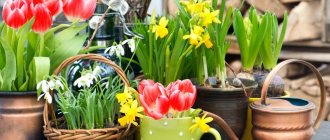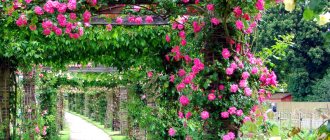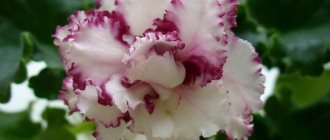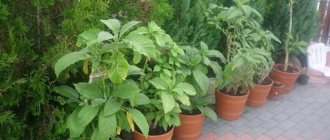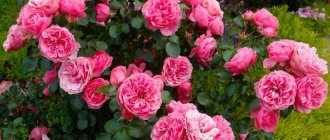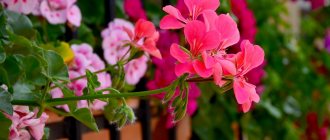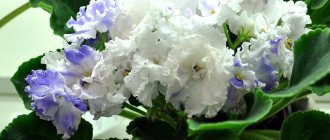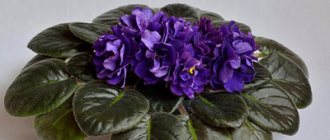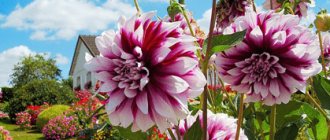Photo: ogo.ua The proud, handsome rhododendron is a permanent resident of the best gardens and parks in Europe. It decorates city flower beds and private collections, and is gradually replacing roses in the design of plots. The densely flowering shrub is the most spectacular of its kind. It is impossible to believe that its closest relatives are cranberries and lingonberries, inconspicuous from a decorative point of view!
general information
Despite the fact that the name rhododendron literally translates as “rose tree,” it has nothing to do with roses. The only thing they have in common is the variety of varieties and fabulous beauty during flowering. And rhododendron belongs to the heather family.
It is most commonly found in the Himalayas, Southeast Asia and Southern China. Some species grow in Japan, North America, New Guinea and Australia. But they are all very different, from tiny creeping shrubs to entire trees.
The length of rhododendron stems in the wild can reach an astonishing 30 m. The flowers can be quite miniature, and sometimes exceed 20 cm in diameter. But there are also compact varieties that love to be grown on windowsills.
Photo: shark-media.ru
What is a garden azalea?
Most garden varieties of rhododendron are shrubs of various shapes. The root system of plants is formed quite compactly and is located quite close to the surface, which makes it possible to transplant a flower from flowerbed to flowerbed without much difficulty.
The rhododendron plant, photos of which are presented in the review, may have petiolate or sessile leaves, located alternately on the shoots. The shape of the leaves is serrate or with a solid edge, obovate or egg-shaped. The color of the inflorescences can also be very diverse - lilac, violet, red, white.
As a rule, rhododendron flowers are collected in brushes or corymbs. Their shape directly depends on the subspecies and variety. She may be:
- funnel-shaped;
- campanulate;
- wheel-shaped;
- tubular
It should also be noted that individual varieties of rhododendron differ in aroma. Some smell very sweet and sharp, others are gentle and soft.
Some varieties of indoor rhododendron flowers can produce fruits in the form of a five-leaf box containing two-millimeter stick seeds. The root system is quite compact, consisting of a huge number of fibrous roots intertwined with each other.
In nature, the flower can occur as a single plant or grow in a group, forming impenetrable thickets with sufficient moisture and in shady places.
Rhododendron species
The rhododendron genus is surprisingly diverse, combining deciduous trees and evergreen shrubs. About eighteen species are common in our country. Let's look at some of them!
Golden rhododendron
An evergreen, squat variety spreads near the ground at a height of about 30-50 cm. It has a spreading crown with large long leaves up to 8 cm long, strewn with yellow-golden flowers. Golden rhododendron lives in the Far East, Altai Territory, Mongolia and some regions of Japan.
Photo: treespk.ru
Albrecht's rhododendron
The most popular Japanese variety decorates many mid-latitude gardens. The shrub grows up to one and a half meters and is densely covered with bright pink or red flowers with an olive center. This rhododendron grows very slowly, but lives up to 30 years.
Photo: energysad.ru
Katevba rhododendron
A spectacular winter-hardy bush, covered with long leathery leaves, stretches up to 4 m. Large inflorescences bloom on it, each of which consists of 15-20 flowers of an unusual purple-lilac hue.
Photo: treespk.ru
Rhododendron Vazea
Alpine rhododendron thrives in northwestern latitudes. This is a shrub, up to 2-5 m with small bright leaves and pale pink flowers. In autumn it turns a rich crimson color and remains decorative. Vazea is considered one of the most beautiful wild rhododendrons.
Photo: flower.onego.ru
Caucasian rhododendron
A low, spectacular rhododendron up to half a meter high often grows creeping, so it looks good in garden landscaping. It has unusual, leathery, oval-shaped leaves with slightly curled edges. The flowers look like funnels of a yellowish or greenish color.
Photo: packagile.ru
Atlantic rhododendron
The North American variety loves moist forests, swamps and sandy coasts. Although it grows to little more than half a meter, it has a dense, spreading crown with large, ovate leaves. The white flowers have a pink tint and are renowned for their strong scent.
Photo: flower.onego.ru
Yellow rhododendron
This beautiful, delicate variety is also called Pontic azalea. It is notable for its large vanilla-yellow or orange flowers with a distinct aroma. This is a deciduous, frost-resistant variety that grows upward from 2 m.
Photo: domashniecvety.ru
Kamchatka rhododendron
A squat, low shrub stretches up to 40 cm, but spreads well throughout the territory. It has small rounded leaves and expressive purple-pink flowers up to 4 cm in diameter.
Photo: pibig.info
Carpal rhododendron
Rhododendron, originally from China, rarely grows above half a meter in the garden. It has a beautiful and neat rounded crown that does not require regular shaping. White, pink or scarlet flowers only one and a half centimeters long are collected in funnels at the tops of the stems.
Photo: cherkessk7m.ru
Blushing rhododendron
An elegant evergreen variety blooms in mid-spring with beautiful purple flowers. Their diameter is only 2.5 cm, but the inflorescences seem large because they consist of 4-5 flowers. Blushing Rhododendron has almost no scent, so this is your choice if you can't stand strong scents.
Photo: econet.ru
Hydrangea (80 photos): types and features of care
We follow the rules
Indoor rhododendron should receive the same procedures as garden crops, but in smaller quantities. Watering should be regular, but not too abundant. Before this procedure, it is recommended to first check the substrate for moisture with your finger. As soon as the soil dries at a distance of 5 centimeters from the surface, it must be shed with well-settled water at room temperature.
In the summer, it is necessary to spray the flower with a spray bottle, except during the time when it is blooming. The procedure is carried out at least twice a week, however, in particularly hot months, daily spraying will not harm the plant. You can also wipe the leaves with a damp cloth to remove dust or place a jar of water next to the flowerpot to create an additional source of air humidity.
As soon as the plant begins to form its first buds, watering and spraying must be doubled so that the flower has enough strength to form them. To soften the water, you can use several handfuls of peat, adding them to a barrel with life-giving liquid, or simply use settled rainwater.
Soil acidification is one of the care features. Indoor rhododendron often lacks acid, so you should sometimes add 1 tablespoon of citric acid or 40 milligrams of table vinegar to the water for irrigation. Similar calculations are suitable for a 10 liter bucket.
To understand when it is best to water an indoor flower, you need to constantly monitor the condition of the plant’s leaves, since they are a kind of indicator that indicates a lack or excess of moisture in the soil. If there is not enough water, they will become soft and matte, and if there is too much water, they will turn a very dark color.
Rhododendron care
Rhododendrons are grown in greenhouses and in rooms, but the general care features remain the same. The main thing is to properly organize wintering and maintain stable temperature and humidity conditions.
Temperature and lighting
Rhododendron prefers more bright light, so it feels good even on the south side. Take indoor flowerpots outside in the summer, but shade them from direct rays. The ideal temperature is about 22 degrees, but 16-18 will do. For the winter, indoor varieties are placed in a cold place (5-8 degrees) for at least a month and a half so that future buds ripen.
Photo: cshh.ru
Watering
In summer, rhododendron is watered every time the top layer of soil dries out. Use only settled warm water, and for indoor flowerpots alternate top and bottom watering. Keep in mind that the flower does not tolerate dry air, so spraying several times a day is normal practice during drought.
Photo: domashniecvety.ru
The soil
Special heather soil is best suited for rhododendron, but moist peat soil will also work. Keep in mind that the flower grows for a long time and needs different conditions at different times of its life. For the winter, the bushes are insulated with spruce branches, spruce branches and burlap. But in warm latitudes, where there are not too severe frosts, this is not necessary.
Photo: zen.yandex.ru
Fertilizers and fertilizing
Rhododendron loves feeding, even if they are very young plants that have not yet bloomed. Use liquid mixtures with the addition of rotted manure or horn meal from early spring until the end of flowering. Make sure that the mail remains acidic, so choose the right formulations.
Photo: floraved.net
Transplantation and propagation
The easiest way to propagate rhododendron is by cuttings, when part of the long branches is dug into the ground. To do this, select several flexible young shoots, bend them into a ditch and cover them with garden soil. The part of the shoot that will remain on top requires vertical support. Already in the fall or next spring you can cut off the branch from the parent and replant.
Rhododendron planted from seed will take 6-8 years to bloom, so be prepared for a long wait. The seedlings spend the first month under film, and the entire first year in a cool greenhouse. When picking, be sure to deepen the cotyledons so that the root system develops better. Young bushes are transplanted into the ground only in the second year.
Photo: giashop.ru
Cuttings are another rather long and complex method, for which you will need semi-lignified stems 5-8 cm long. Tear off the lower leaves from them and place them in a stimulating solution for root growth. Use a substrate of sand and peat and cover the young seedlings with a transparent dome.
Rooting of cuttings can last from 1.5 to 4.5 months, depending on the variety. Then they are planted in boxes, the next spring they are dug into the ground with the boxes, and after 1-2 years they are transplanted to a permanent place.
Photo: datchnik.ru
Trimming
Rhododendrons are naturally very good and neat, so they do not need pruning for shaping. Only rejuvenation or preventive pruning is carried out if the bush has become too tall. After winter, be sure to cut off frozen stems, but it is important to do this before the weather warms up and the sap begins to flow actively.
Photo: farmer.blog
Tree hydrangea: varieties, care features (60 photos)
Planting in open ground
A more convenient and faster way to grow rhododendron is to plant a ready-made seedling.
Selection of seedlings
More often, seedlings from nurseries in Holland and Germany are sold in stores. Varieties of Finnish selection are also valued. They are sold in pots. When purchasing, you need to make sure that the root system of the plant is in order. The earthen ball should be entwined with roots. It’s good if they show threads of mycorrhiza, which allows the roots to absorb nutrients normally. Before purchasing, you need to remove the plant from the pot to make sure everything is in order. The leaves should not have any spots, there should be no mold or white coating on the trunk.
Before purchasing a seedling, it is worth studying the group to which it belongs, its variety and origin (species or hybrid). Also take into account the size of the shrub in adulthood, its frost resistance, and growth rate. Beginning gardeners should not purchase many copies of the plant. It is better to stop at one and make sure that they are capable of growing rhododendron.
Choice of location and lighting
Rhododendrons can grow in almost any area.
The main thing is that it is protected from direct sun and strong wind. It is preferable to choose semi-shaded areas. But some deciduous species can grow in well-lit places. On a note! The culture does not like stagnant moisture. Therefore, you should not plant it in closed lowlands, hollows, wetlands and flooded areas. Groundwater must be at a depth of at least a meter to the surface. The soil for shrubs is loose, well-drained, with a lot of humus and an acidic reaction.
Landing dates
In temperate climates, it is advisable to plant plants with high cold resistance. Spring planting of seedlings can be carried out from April to mid-May. The best time for this in the fall is September. Although you can choose any time during the growing season, except for the flowering period, as well as within 1-2 weeks after it.
Landing rules
Dig a planting hole with a diameter of 60 cm and a depth of 40 cm. Fill it with a mixture of 3.5 buckets of loam and 8 buckets of high-moor peat. Compact well, then dig a hole equal in size to the root system of the seedling. Place the plant in water before planting and wait until bubbles begin to appear. Place the seedling in the hole, fill it with soil, and compact it well. Do not deepen the root collar. Water the bush generously so that the water saturates the soil to a depth of 20 cm. Cover the trunk area with mulch (peat, pine needles, oak leaves) 5-6 cm thick. If only one rhododendron seedling is planted, it needs to be supported. When the bush takes root well, it can be removed.
Pest and disease control
The main scourge of all rhododendrons is the rhododendron bug, which leaves whitish spots on the leaves. It is a large parasite, up to 3-4 mm in size, so it can be noticed even this way. The bug lays eggs on the back of the plates, and new offspring wake up after wintering.
Rhododendron also faces more typical problems - spider mites or weevils. Thrips, garden beetles or narrow-winged moths may appear. The principle of operation is the same - timely treatment of seedlings with insecticides.
If yellow spots grow on the tips of rhododendron leaves, this is most likely mixed chlorosis. The most common reasons are lack of fertilizers or stagnant water. Another indicator of nutritional deficiency is red-brown spots along the veins. And if the rhododendron is too cold, the leaves may even die off.
Photo: mm-ewm.ru
Reproduction
Rhododendrons are propagated vegetatively and by seeds.
Cuttings:
Rhododendron cuttings 10-15 cm long are cut after flowering ends, in June or July. The cut is made at an angle.
IN THE PHOTO: Cuttings help to fully preserve the varietal characteristics of Rhododendrons during propagation.
The cutting must be taken with a wood “heel”. The apical leaves cut in half are left on the treated shoot.
For rapid germination, it is recommended to pre-treat the cuttings with a light pink solution of potassium permanganate. Before planting, it is worth dipping the shoot into a solution of Heteroauxin, prepared by diluting one tablet in a liter of water.
The prepared cuttings are planted in a light peat substrate without additives and covered with film. Provide a temperature of +22–25°C. After two to three months, the shoots take root.
The rooting process is accelerated by illuminating the cuttings. The publication “Basics of proper lighting for indoor plants” will tell you about choosing a device for this purpose and more.
Rooted shoots are grown in boxes filled with pine needles and acidified peat 1:2. Two weeks after transplantation, feed with a 2% urea solution (2 grams per liter of water). The temperature is reduced to +8–12°C. In the future, the grown cuttings of Rhododendron can be grown in the beds when the weather warms up or left for a year or two in a container.
Seed method:
Rhododendron is sown in spring. Bowls or boxes are suitable for growing a bush or tree from seeds. Seeds are sown on the surface of a soil mixture of sand and peat 1:1. After this, they are sprinkled with washed sand and watered abundantly.
The seeds are covered with glass or film to maintain moisture and kept at room temperature. After three to four weeks, shoots appear.
IN THE PHOTO: Rhododendron seedlings.
Strong seedlings with the first leaves are kept at a temperature of +8–12°C for hardening. It is important to provide the seedlings with 16–18 hours of daylight.
Picking of grown seedlings is done twice: in June and February-March. In the third year of life, young Rhododendrons are planted for growing in a greenhouse or garden bed.
When grown from seeds, Rhododendron will bloom only in the third or fourth year. Rhododendrons from cuttings can bloom the next year after planting.
Rhododendron – photo
Rhododendrons look great alone or in groups with other moisture-loving plants. They are regularly used for landscaping areas. Just look how beautiful it is!
Photo: agroevropa.ru Photo: flo.discus-club.ru
Photo: flo.discus-club.ru
Photo: tapeciarnia.pl
Photo: cvetyphoto.blogspot.com
Photo: tr.pinterest.com
Photo: vladimirkrym.livejournal.com
Photo: attuale.ru
Photo: attuale.ru
Photo: 10wallpaper.com Photo: dlobal.ru
Photo: domashniecvety.ru
Photo: vladimir-shalaev.tourister.ru
Photo: pibig.info
Photo: u-florista.ru
Photo: bskod.ru
Photo: interjer-plus.ru
Photo: rhodoland.nl
Photo: aredi.ru
Photo: bezgoroda.com
Photo: dlobal.ru
Photo: distano.ru
Photo: oir.mobi
Photo: peakpx.com
Photo: zen.yandex.ru
Photo: dachneek.ru
Ageratum (70 photos): types and features of care
Plant pruning
Typically, this shrub does not require pruning, as it forms a beautiful crown on its own . Sometimes it is necessary to trim some branches or cut off frozen or dry shoots.
To perform proper pruning, you need to do it in early spring. The cut areas must be treated with charcoal or garden pitch. After about thirty days, buds form on the shoots and the renewal process begins.
This shrub has the following characteristic: in one year there is abundant flowering, and in the next season much fewer inflorescences are formed . To get rid of this deficiency, it is necessary to prune half the plant alternately every other year.
Bloom
When and how does this happen?
The flowering of dwarf rhododendron is generous, abundant, and occurs in May or at the very beginning of June. Lasts 3 weeks. The crown is dense, compact, and during flowering the leaves are almost invisible. Many varieties can bloom again in late August - early September.
Conditions of detention
Dwarf rhododendron is usually replanted before and after flowering. During bud ripening, the temperature should be reduced to 10 – 12 °C. After flowering, very elongated shoots are cut off. Old inflorescences should be trimmed immediately after flowering for future flowering.
What to do if there are no buds?
For abundant flowering and the formation of new buds, you need to feed the bush with superphosphate. You should also check the bushes for fungi and garden pests.
The best varieties for regions
Varieties and varieties are selected for planting depending on the climatic zone. Not all varieties can withstand harsh cold winters. And yet, there are many species and varieties that are successfully grown in the Moscow region and Leningrad, in the Urals and Siberia. They are often planted in groups or in combination with conifers.
Did you know? Rhododendron acuminate in Japan, Korea, northern China and the Ussuri region is used to treat heart diseases, stomach diseases and infections. Dahurian and Caucasian rhododendron are no less useful.
For the Moscow region and the middle zone
Many types of rhododendrons are successfully grown in open ground at the State Botanical Garden in Moscow. Rhododendron acuminate, Dahurian, Canadian, short-fruited, Japanese, sea buckthorn, Smirnov, Ledebur and Schlippenbach performed well in the central zone of the Russian Federation.
For the middle zone, including the Moscow region, with a temperate climate, it is better to choose deciduous or semi-deciduous varieties. Varieties from the Lights series are well suited, for example, Mandarin Lights, Lemon Lights, Golden Lights, as well as PJM and Finnish hybrids, Nova Zembla and others.
History of origin
Dwarf rhododendron is an alpine endemic in the East. Their range is limited; unfortunately, natural species belong to rare plants; many varieties are listed in the Red Book.
Dwarf rhododendron is an ornamental shrub; with its participation in modern breeding, many intergeneric hybrids of Calmiopsis, flowering Phyllodoceae of the Veresaceae family have been bred.
Fertilizing bushes
This plant must be fertilized, even if recently planted. The first feeding is carried out in the spring. Before fertilizing, the plant must be watered. For organic fertilizers, manure diluted with water is suitable. Since the shrub grows in acidic soil, nitrogen fertilizers and potassium phosphate can be used as mineral fertilizers.
It is best to fertilize the plant in the spring with nitrogen-containing fertilizers, and in early summer with sulfuric acid fertilizers.

